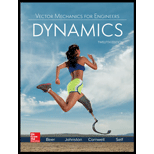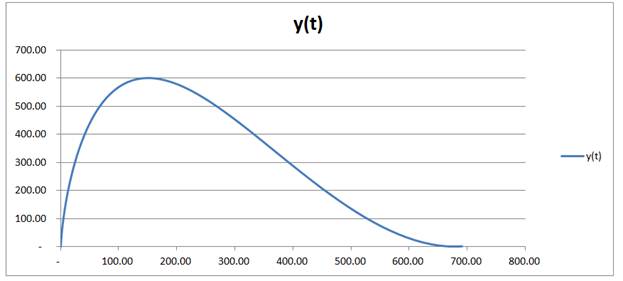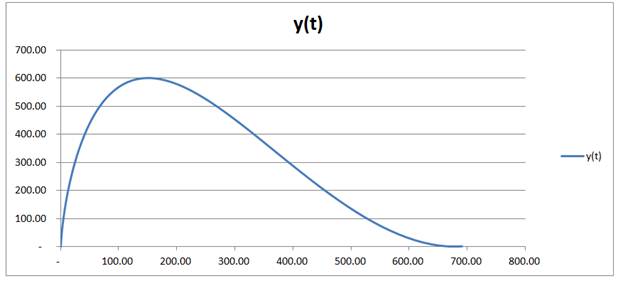
Concept explainers
Students are testing their new drone to see if it can safely deliver packages to different departments on campus. Position data can be approximated using the expressions
(a)
The duration of flight.
Answer to Problem 11.182RP
We got the time of flight is
Explanation of Solution
Given information:
Time
Concept used:
We shall draw graph (plot of path)
Calculation:
Following table is made-
| t | 0.00 | 1.00 | 10.00 | 20.00 | 30.00 | 39.00 | 40.00 | 50.00 | 60.00 | 70.00 |
| x(t) | 0.00 | 0.01 | 3.78 | 24.40 | 71.78 | 141.11 | 150.40 | 259.38 | 392.40 | 537.78 |
| y(t) | 0.00 | 0.93 | 87.89 | 300.06 | 512.20 | 599.08 | 600.00 | 512.02 | 299.82 | 87.72 |
| t | 79.00 | 80.00 | 81.00 | 82.00 |
| x(t) | 665.15 | 678.40 | 691.38 | 704.07 |
| y(t) | 0.91 | 0.00 | 0.94 | 3.73 |
Plot,

From above table and plot we get the take off and landing altitudes are the same at
Hence the time of flight is
Conclusion:
We got the time of flight is
(b)
The maximum speed in x direction.
Answer to Problem 11.182RP
We got the maximum horizontal speed
Explanation of Solution
Given information:
Time
Concept used:
Speed
For maximum speed
Calculation:
Speed
For maximum speed
On putting value of
Conclusion:
We got the maximum horizontal speed
(c)
The maximum altitude
The horizontal distance of the flight.
Answer to Problem 11.182RP
We get the maximum altitude,
And horizontal distance traveled,
Explanation of Solution
Given information:
Time
Concept used:
We shall draw graph (plot of path)
Calculation:
Following table is made-
| t | 0.00 | 1.00 | 10.00 | 20.00 | 30.00 | 39.00 | 40.00 | 50.00 | 60.00 |
| x(t) | 0.00 | 0.01 | 3.78 | 24.40 | 71.78 | 141.11 | 150.40 | 259.38 | 392.40 |
| y(t) | 0.00 | 0.93 | 87.89 | 300.06 | 512.20 | 599.08 | 600.00 | 512.02 | 299.82 |
| t | 70.00 | 79.00 | 80.00 | 81.00 | 82.00 |
| x(t) | 537.78 | 665.15 | 678.40 | 691.38 | 704.07 |
| y(t) | 87.72 | 0.91 | 0.00 | 0.94 | 3.73 |
Plot,

From above table and plot we get the maximum altitude,
And horizontal distance travelled,
Conclusion:
We get the maximum altitude,
And horizontal distance travelled,
Want to see more full solutions like this?
Chapter 11 Solutions
Vector Mechanics For Engineers
Additional Engineering Textbook Solutions
Starting Out with Java: From Control Structures through Objects (7th Edition) (What's New in Computer Science)
Modern Database Management
Elementary Surveying: An Introduction To Geomatics (15th Edition)
Starting Out with Programming Logic and Design (5th Edition) (What's New in Computer Science)
Mechanics of Materials (10th Edition)
Database Concepts (8th Edition)
- 3.) 15.40 – Collar B moves up at constant velocity vB = 1.5 m/s. Rod AB has length = 1.2 m. The incline is at angle = 25°. Compute an expression for the angular velocity of rod AB, ė and the velocity of end A of the rod (✓✓) as a function of v₂,1,0,0. Then compute numerical answers for ȧ & y_ with 0 = 50°.arrow_forward2.) 15.12 The assembly shown consists of the straight rod ABC which passes through and is welded to the grectangular plate DEFH. The assembly rotates about the axis AC with a constant angular velocity of 9 rad/s. Knowing that the motion when viewed from C is counterclockwise, determine the velocity and acceleration of corner F.arrow_forward500 Q3: The attachment shown in Fig.3 is made of 1040 HR. The static force is 30 kN. Specify the weldment (give the pattern, electrode number, type of weld, length of weld, and leg size). Fig. 3 All dimension in mm 30 kN 100 (10 Marks)arrow_forward
- (read image) (answer given)arrow_forwardA cylinder and a disk are used as pulleys, as shown in the figure. Using the data given in the figure, if a body of mass m = 3 kg is released from rest after falling a height h 1.5 m, find: a) The velocity of the body. b) The angular velocity of the disk. c) The number of revolutions the cylinder has made. T₁ F Rd = 0.2 m md = 2 kg T T₂1 Rc = 0.4 m mc = 5 kg ☐ m = 3 kgarrow_forward(read image) (answer given)arrow_forward
- 11-5. Compute all the dimensional changes for the steel bar when subjected to the loads shown. The proportional limit of the steel is 230 MPa. 265 kN 100 mm 600 kN 25 mm thickness X Z 600 kN 450 mm E=207×103 MPa; μ= 0.25 265 kNarrow_forwardT₁ F Rd = 0.2 m md = 2 kg T₂ Tz1 Rc = 0.4 m mc = 5 kg m = 3 kgarrow_forward2. Find a basis of solutions by the Frobenius method. Try to identify the series as expansions of known functions. (x + 2)²y" + (x + 2)y' - y = 0 ; Hint: Let: z = x+2arrow_forward
- 1. Find a power series solution in powers of x. y" - y' + x²y = 0arrow_forward3. Find a basis of solutions by the Frobenius method. Try to identify the series as expansions of known functions. 8x2y" +10xy' + (x 1)y = 0 -arrow_forwardHello I was going over the solution for this probem and I'm a bit confused on the last part. Can you please explain to me 1^4 was used for the Co of the tubular cross section? Thank you!arrow_forward
 Elements Of ElectromagneticsMechanical EngineeringISBN:9780190698614Author:Sadiku, Matthew N. O.Publisher:Oxford University Press
Elements Of ElectromagneticsMechanical EngineeringISBN:9780190698614Author:Sadiku, Matthew N. O.Publisher:Oxford University Press Mechanics of Materials (10th Edition)Mechanical EngineeringISBN:9780134319650Author:Russell C. HibbelerPublisher:PEARSON
Mechanics of Materials (10th Edition)Mechanical EngineeringISBN:9780134319650Author:Russell C. HibbelerPublisher:PEARSON Thermodynamics: An Engineering ApproachMechanical EngineeringISBN:9781259822674Author:Yunus A. Cengel Dr., Michael A. BolesPublisher:McGraw-Hill Education
Thermodynamics: An Engineering ApproachMechanical EngineeringISBN:9781259822674Author:Yunus A. Cengel Dr., Michael A. BolesPublisher:McGraw-Hill Education Control Systems EngineeringMechanical EngineeringISBN:9781118170519Author:Norman S. NisePublisher:WILEY
Control Systems EngineeringMechanical EngineeringISBN:9781118170519Author:Norman S. NisePublisher:WILEY Mechanics of Materials (MindTap Course List)Mechanical EngineeringISBN:9781337093347Author:Barry J. Goodno, James M. GerePublisher:Cengage Learning
Mechanics of Materials (MindTap Course List)Mechanical EngineeringISBN:9781337093347Author:Barry J. Goodno, James M. GerePublisher:Cengage Learning Engineering Mechanics: StaticsMechanical EngineeringISBN:9781118807330Author:James L. Meriam, L. G. Kraige, J. N. BoltonPublisher:WILEY
Engineering Mechanics: StaticsMechanical EngineeringISBN:9781118807330Author:James L. Meriam, L. G. Kraige, J. N. BoltonPublisher:WILEY





